The AMD Radeon VII Review: An Unexpected Shot At The High-End
by Nate Oh on February 7, 2019 9:00 AM ESTCompute Performance
Shifting gears, we'll look at the compute aspects of the Radeon VII. Though it is fundamentally similar to first generation Vega, there has been an emphasis on improved compute for Vega 20, and we may see it here.
Beginning with CompuBench 2.0, the latest iteration of Kishonti's GPU compute benchmark suite offers a wide array of different practical compute workloads, and we’ve decided to focus on level set segmentation, optical flow modeling, and N-Body physics simulations.
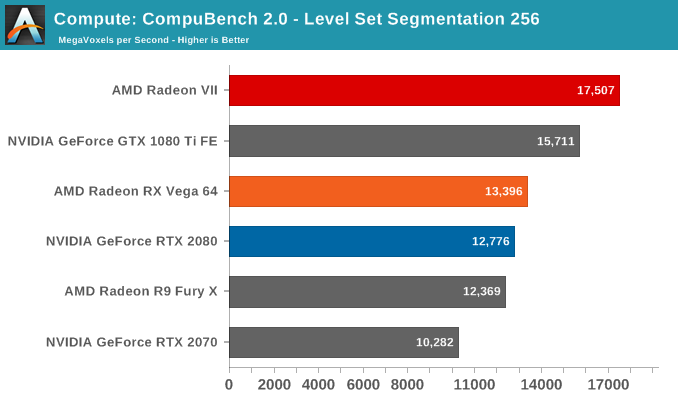
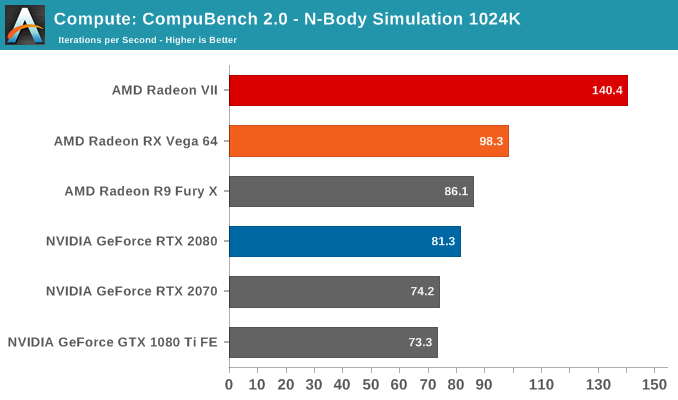
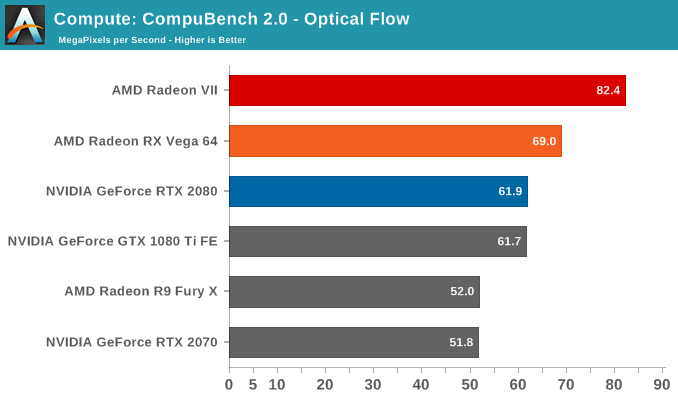
Moving on, we'll also look at single precision floating point performance with FAHBench, the official Folding @ Home benchmark. Folding @ Home is the popular Stanford-backed research and distributed computing initiative that has work distributed to millions of volunteer computers over the internet, each of which is responsible for a tiny slice of a protein folding simulation. FAHBench can test both single precision and double precision floating point performance, with single precision being the most useful metric for most consumer cards due to their low double precision performance.
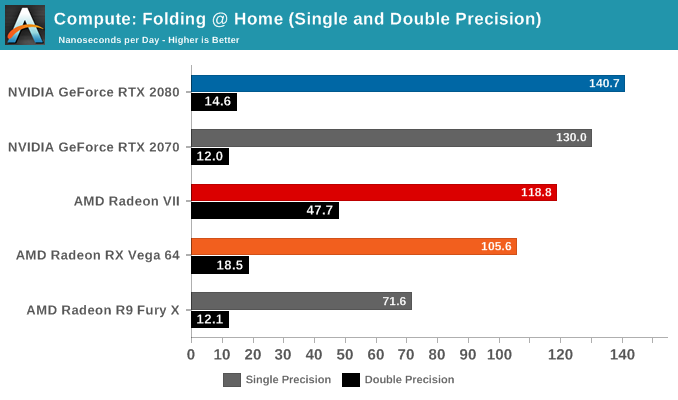
Next is Geekbench 4's GPU compute suite. A multi-faceted test suite, Geekbench 4 runs seven different GPU sub-tests, ranging from face detection to FFTs, and then averages out their scores via their geometric mean. As a result Geekbench 4 isn't testing any one workload, but rather is an average of many different basic workloads.
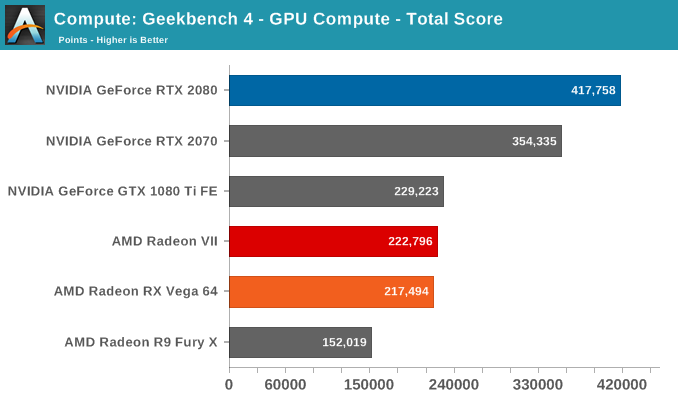
Lastly, we have SiSoftware Sandra, with general compute benchmarks at different precisions.
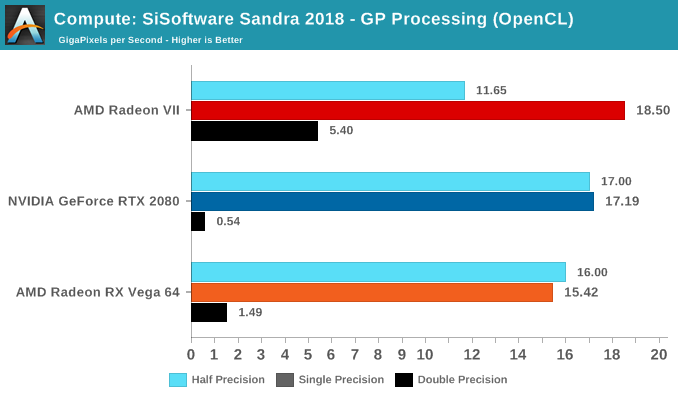
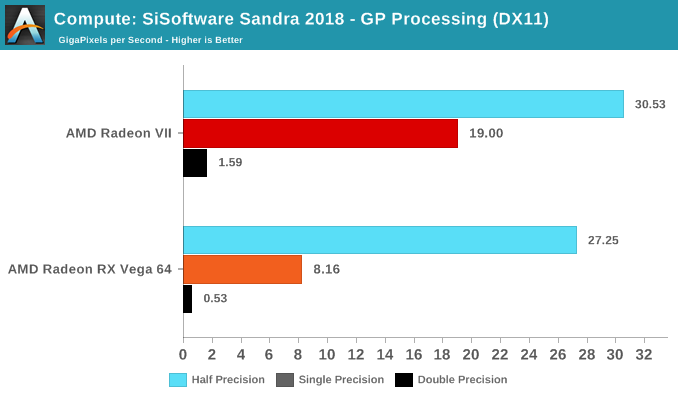
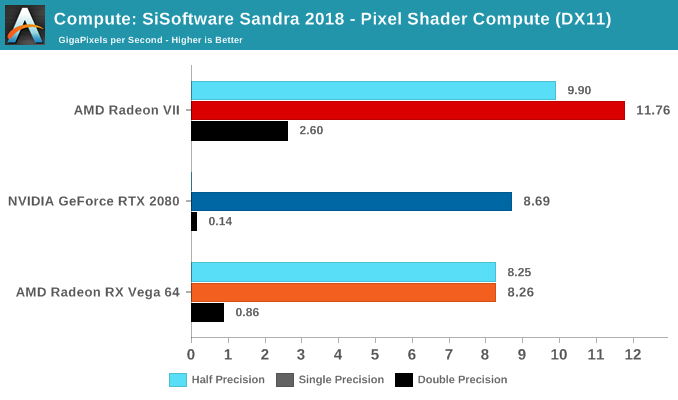










289 Comments
View All Comments
eva02langley - Thursday, February 7, 2019 - link
I should not say realistic, I should say credible.webdoctors - Thursday, February 7, 2019 - link
Open source is NOT the only way a new standard can be adopted. Microsoft has been pushing DirectX 9/10/11, etc. and those are HUGELY popular standards. If MS is adopting it in their API, than yes it'll show up in PC games.Raytracing is not a gimmick, its been around since before you were born or Nvidia was even founded. It hasn't been "feasible" for real-time and as such as been largely ignored in gaming. Many other technologies were not feasible until they were and than got incorporated. Graphics is more than just getting 60FPS otherwise everything would just be black and white without shadows. Its about realism, which means proper lighting, shadows, physics.
Ppl need to call out the price, if you're a regular joe who's just getting a card for gaming and not mining or business use, why would you buy this over the competition? They seriously need to drop the price by $100 or it'll be a tiny seller.
D. Lister - Friday, February 8, 2019 - link
RTX is just Nvidia's way of doing DXR which is the IP of Microsoft. AMD has already announced specific development for it in future to be integrated in their GPU's. RT has been announced by both Sony and MS for their next consoles. Of course because of their use of AMD GPUs, the application of RT would be of a lower quality compared to what RTX can do. It is very much like the current console implementation of anti-aliasing, HBAO or tessellation, where on consoles you get a very basic level of those features, but on decent PCs they can be cranked up much higher."The whole G-synch fiasco should have been enough to prove it."
This is nothing like G-Sync. The problem with GSync is the extra cost. Now considering that the 2080 is the same price/performance as a Radeon VII, but has hardware DXR (RTX) as well, you're essentially getting the ray-tracing add-in for free.
Thirdly, while many things can be faked with rasterization to be within the approximation of ray-tracing, it requires far greater work (not to mention, artistic talent) to do it. In rasterization, a graphics designer has to first guess what a certain reflection or shadow would look like and then painstakingly make something that could pass off for the real thing. Raytracing takes that guesswork out of the task. All you, as a developer, would need to do is place a light or a reflective surface and RT would do the rest with mathematical accuracy, resulting in higher quality, a much faster/smoother development, fewer glitches, and a much smaller memory/storage footprint for the final product.
D. Lister - Friday, February 8, 2019 - link
A helpful link:https://blogs.msdn.microsoft.com/directx/2018/03/1...
Manch - Friday, February 8, 2019 - link
RTX is a proprietary implementation that is compatible with DirectX RT. AMD may eventually do DirectX RT but it will be there own version. As far as consoles go, unless NAVI has some kind of RT implementation, youre right, no RT of any significance. At best it will be a simple PC graphics option that works in a few titles maybe like hair works lol.eva02langley - Friday, February 8, 2019 - link
It is ... a GAMEWORKS feature... as of now. RTX/DLSS are nothing more than 2 new gameworks features... that will just break games, once again to cripple the competition.The goal is not even to have RTX or DLSS, it is to force developers to use their proprietary tools to break game codes and sabotage the competition, like The Witcher 3.
RTX is nothing good as of now. It is a tax, and it breaks performances. Let's talk about it when it can be implemented in real-time. until then, let's Nvidia feel the burden of it.
eddman - Friday, February 8, 2019 - link
I do agree that these RTX/DLSS features absolutely do not justify the current prices and that nvidia should've waited for 7nm to mature before adding them, but let's not get so emotional.Gameworks are simply modules that can be added to a game and are not part of the main code. Also, its GPU based features can be disabled in options, as was the case in witcher 3.
TheinsanegamerN - Thursday, February 7, 2019 - link
And by flinging insults you have shown yourself to be an immature fanboi that is desperately trying to defend his favorite GPU company.eva02langley - Friday, February 8, 2019 - link
I didn't insult anyone, I just spoke the truth about RTX. I am not defending AMD, I am condemning Nvidia. Little difference...To defend RTX as it is today, is being colored green all over. There is no way to defend it.
ballsystemlord - Thursday, February 7, 2019 - link
I agree, Huang should have listed to himself when he said that Ray tracing would have been a thing in 10 years (but he wanted to bring it to market now).Remember when there were 2D and 3D accelerators?
I say we should be able to choose 3D or Ray-tracing accelerators.